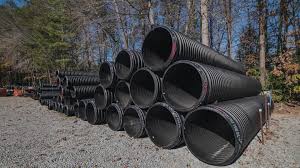Apr . 25, 2024 10:59 Back to list
High-density polyethylene
High-density polyethylene
High-density polyethylene (HDPE) or polyethylene high-density (PEHD) is a thermoplastic polymer produced from the monomer ethylene. It is sometimes called "alkathene" or "polythene" when used for HDPE pipes. With a high strength-to-density ratio, HDPE is used in the production of plastic bottles, corrosion-resistant piping, geomembranes and plastic lumber. HDPE is commonly recycled, and has the number "2" as its resin identification code.
In 2007, the global HDPE market reached a volume of more than 30 million tons.
Properties
HDPE is known for its high strength-to-density ratio. The density of HDPE ranges from 930 to 970 kg/m3. Although the density of HDPE is only marginally higher than that of low-density polyethylene, HDPE has little branching, giving it stronger intermolecular forces and tensile strength (38 MPa versus 21 MPa) than LDPE.[6] The difference in strength exceeds the difference in density, giving HDPE a higher specific strength. It is also harder and more opaque and can withstand somewhat higher temperatures (120 °C/248 °F for short periods). High-density polyethylene, unlike polypropylene, cannot withstand normally required autoclaving conditions. The lack of branching is ensured by an appropriate choice of catalyst (e.g., Ziegler–Natta catalysts) and reaction conditions.
HDPE is resistant to many different solvents, and is exceptionally challenging to glue; joints are typically made by welding.
The physical properties of HDPE can vary depending on the molding process that is used to manufacture a specific sample; to some degree, a determining factor is the international standardized testing methods employed to identify these properties for a specific process. For example, in rotational molding, to identify the environmental stress crack resistance of a sample, the notched constant tensile load test (NCTL) is put to use.
Owing to these desirable properties, pipes constructed out of HDPE are ideally applicable for drinking water[9] and waste water (storm and sewage).
HDPE is also used for cell liners in United States subtitle D sanitary landfills, wherein large sheets of HDPE are either extrusion welded or wedge welded to form a homogeneous chemical-resistant barrier, with the intention of preventing the pollution of soil and groundwater by the liquid constituents of solid waste.
HDPE is preferred by the pyrotechnics trade for mortars over steel or PVC tubes, being more durable and safer: HDPE tends to rip or tear in a malfunction instead of shattering and becoming shrapnel like the other materials.
Milk bottles, jugs, and other hollow goods manufactured through blow molding are the most important application area for HDPE, accounting for one-third of worldwide production, or more than 8 million tonnes.
Above all, China, where beverage bottles made from HDPE were first imported in 2005, is a growing market for rigid HDPE packaging, as a result of its improving standard of living. In India and other highly populated, emerging nations, infrastructure expansion includes the deployment of pipes and cable insulation made from HDPE. The material has benefited from discussions about possible health and environmental problems caused by PVC and polycarbonate associated bisphenol A (BPA), as well as its advantages over glass, metal, and cardboard.
DN150 HDPE pipes for gas delivery
Production
Industrial production of HDPE from ethylene happens through either Ziegler-Natta polymerization or the Phillips slurry process. The Ziegler-Natta method uses a combination of catalysts, including titanium tetrachloride, in contact with gaseous ethylene to precipitate high-density polyethylene.In a similar way, the Phillips slurry process uses silica-based catalysts in contact with a fast-moving hydrocarbon and polyethylene slurry to precipitate high density polyethylene.
Processing will determine the properties of the HDPE. The method used to synthesize the HDPE is crucial because the micro structure of the HDPE will vary. The Phillips Slurry process results in HDPE with less branching and more precise molecular weights than the Ziegler process, but the Ziegler process provides greater flexibility in the type of polyethylene produced.
The molecular weight of HDPE refers to the length of the polyethylene chains, and helps determine properties such as flexibility, yield strength, and melt temperature. After the precipitate is formed, the temperature, pressure, and cooling time during processing will dictate the degree of crystallinity, with a higher degree of crystallinity resulting in greater rigidity and chemical resistance. Depending on the application, the method and processing steps can be adjusted for an ideal result.
Once the HDPE has been synthesized, it is ready to be used in commercial products. Industrial production methods for HDPE products include injection molding for complex shapes such as toys. Extrusion molding is used for constant-profile products such as pipes and films. Blow molding is intended for hollow products, specifically bottles and plastic bags. Rotational molding is used for large, seamless parts such as chemical drums and kayaks. The method used during processing depends on the product requirements, with each having benefits for a given application.
-
Water Pressure Optimization for HDPE Pipe for Irrigation
NewsAug.07,2025
-
Temperature Tolerance of UPVC Column Pipes
NewsAug.07,2025
-
Root Intrusion Resistance of PVC Sewer Pipe
NewsAug.07,2025
-
Leak Prevention in PPR Plumbing Pipe Connections
NewsAug.07,2025
-
Installation Steps for HDPE Water Supply Pipe
NewsAug.07,2025
-
Cleaning Techniques for Water Lines Under Sink
NewsAug.07,2025


